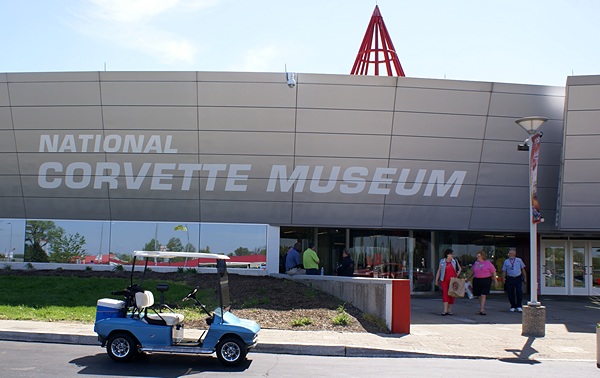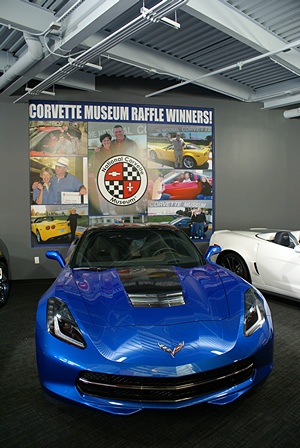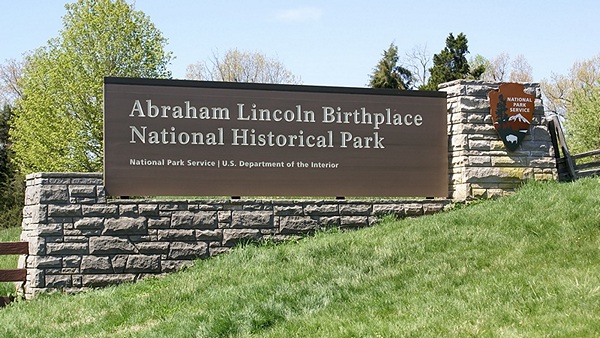As forecast, we had thunderstorms overnight. Light rain started before we went to bed, but the most intense weather was between 3 and 4 AM with lightning, thunder, and intermittent heavy downpours. It is impossible to sleep through such weather even if we could completely darken the bedroom, which we cannot, as the sound of the storm is omnipresent and the wind rocks the motorcoach. Once the storms subside, however, the sound of gentle rain on the roof makes for ideal sleeping conditions. The good news was that none of our usual leaks appeared.
We had three things on our agenda for today—breakfast at Panera, the National Corvette Museum, and grocery shopping—all of which were in Bowling Green, Kentucky. Since we were having breakfast out we did not make coffee at home and used the time normally devoted to breakfast to take showers. Mundane, perhaps, but we keep the cats’ litter tray in the shower, so using it for its intended purpose requires at but more work than it might otherwise.
We left around 9 AM to dark, cloudy skies but with a forecast for steadily improving conditions across the region throughout the day. We took I-65 to make time and took exit 22 onto US-231, the main commercial drag into Bowling Green. We stopped at the visitor information center and got some local maps and information. The Bowling Green Panera was just down the road and we were there by 10:30 AM. Maybe it’s a southern thing, or perhaps a smaller town thing, but this was the third Panera we have been in recently where we had to wait in line while the person behind the counter carried on a personal conversation with the 1st person in line way beyond any reasonable definition of customer service. But I was patient and eventually got our bagels and coffee. Not that I had much of a choice; it was the only Panera for 100 miles or more in any direction from where we are camped.
Panera is a great place to sit and enjoy unlimited free refills of excellent coffee and use free Wi-Fi. The Wi-Fi is not secure but they do require you to log in to their network to accept their terms and conditions of use. Part of those T&Cs is a notice to please limit your use of the system to 30 minutes during the busy lunch period. We have never seen that enforced until today when both of our iPads got cutoff and we received a message that we would not be allowed to reconnect until after 2 PM. 🙁 It was past noon by that point and we were ready to move on anyway. The place was busy, but this was the first time we had ever had our use of Panera’s Wi-Fi system curtailed.
We headed over to the National Corvette Museum where a big “bash” was taking place. The museum was open for general admission, but plant tours required reservations which were no longer available as of two weeks ago. The main parking lots were filled with Corvettes and we were parked in a field a short distance away. Because of the “bash” the lobby was packed with vendors and people, but once we paid our senior admission of $8 (each) and went into the display area it was quiet and not crowded.
The NCM was built, and is run by, a private foundation. It is not owned, or operated, by General Motors but enjoys a very close working relationship with the company, including the fact that it is on the same street as the factory where the cars have been built since production was moved there in 1981. Neither of us are “car people” but we found this to be an excellent museum and thoroughly enjoyed our time looking at the cars, reading about them, and trying to photograph them in the subdued museum lighting.
Because the “bash” was going on, the museum had opened the area where a massive sinkhole opened up on February 12, swallowing eight priceless Corvettes. Since that event all of the cars had been recovered from the hole and put on display “as is.” Most were badly damaged, some beyond recognition or any hope of repair. Work was also underway to stabilize the sinkhole and ultimately rebuild that part of the museum and return it to service. We had to sign liability waivers in order to enter this area of the museum and see the sinkhole. After we were done in the museum we walked around part of the parking lot looking at the Corvettes parked there before walking back to our car.
We back-tracked towards downtown and stopped at a Kroger’s supermarket across the street from the Western Kentucky University medical complex. This was the largest, and nicest, Kroger’s store we have ever been in. We picked up the things we needed to take care of our food needs for the rest of the trip home. Linda found a “power mix” of salad greens that included Mizuna, a slightly peppery and very tasty green that we had not heard of or seen before, even at a Whole Foods.
We took US-31W from Bowling Green through beautiful rolling farm lands back to Cave City. After unloading the groceries I had a brief chat with one of the guys from the Airstream caravan who filled me in on a few more details about how the caravan operates. The whole group had also been at the NCM today and got to tour the factory.
Linda made a pot of crushed lentil soup for dinner, from a recipe she has used before, and served it with a salad of the wonderful “power mix” greens and an “Asian” dressing. On a walk after dinner we met a young couple, also out for an evening stroll, with their 2-year old, Dakota. They said he enjoyed RVing, especially the rocks and the trains, and was a good traveler. As long as he likes trains he has a bright future ahead as an RVer.


